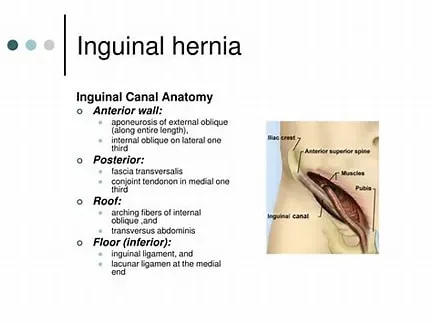Introduction
Inguinal Hernia – a term that might sound intimidating, but fear not! We’re here to unravel the mysteries surrounding this common medical condition. Let’s embark on a journey to explore what an inguinal hernia is, its causes, prevention, and treatment options.
What is an Inguinal Hernia?
An inguinal hernia occurs when tissue, such as part of the intestine, protrudes through a weak spot in the abdominal muscles. Picture this: your abdominal wall is like a well-fortified castle, and an inguinal hernia is like a small breach in its defenses.
Understanding the Anatomy
To truly grasp the concept, let’s break it down. The inguinal canal is a passage in the lower abdomen that houses the spermatic cord in men or the round ligament in women. Weakness in this area allows a hernia to emerge, creating a bulge that can be felt and sometimes seen.
Causes and Risk Factors
Why do hernias occur? Various factors contribute, such as aging, strenuous physical activity, chronic coughing, and even genetics. Men are more prone to inguinal hernias due to the natural structure of their anatomy, but women aren’t entirely off the hook.
The Silent Intruder: Symptoms
Detecting an inguinal hernia is like identifying an uninvited guest. Common symptoms include a visible bulge, pain or discomfort, and a dragging sensation in the abdomen. It’s your body’s way of signaling that something is amiss.
Prevention Techniques
Preventing hernia involves a blend of lifestyle choices and mindfulness. Maintaining a healthy weight, avoiding heavy lifting, and incorporating core-strengthening exercises into your routine can fortify those abdominal walls, making them less susceptible to breaches.
Treatment Options
So, what happens if the fortress is breached? Fear not, modern medicine has a range of solutions. While some small hernias may not require immediate attention, others might need surgical intervention to mend the breach and reinforce the defenses.
Surgical Marvels: Hernia Repair
In the realm of medical interventions, hernia repairs stand as a testament to human ingenuity. Surgeons use various techniques, including open surgery and minimally invasive approaches, to mend the weakened area and restore the integrity of the abdominal wall.
Recovery and Rehabilitation
After the surgical skirmish, a crucial period of recovery ensues. Rest, dietary adjustments, and adherence to post-operative care instructions are vital components of a smooth rehabilitation process. Think of it as allowing the castle’s builders to reinforce the weakened wall.
The Bright Side: Prognosis
Now that we’ve navigated the battlefield, let’s discuss the positive outlook. Inguinal hernias, when promptly addressed, generally have a favorable prognosis. With modern medical advancements and a proactive approach, many individuals return to their daily lives with minimal disruptions.
Hernias Unveiled: Debunking Myths
Hernias, particularly inguinal ones, often carry myths and misconceptions. Let’s dispel some of these shadows and shed light on the realties.
Myth: Only the Elderly Get Hernias
Contrary to popular belief, hernias don’t discriminate based on age. While they are more common in older adults due to weakened muscles over time, even the young and sprightly can find themselves facing this abdominal conundrum.
Myth: Hernias Are Only a Male Problem
Yes, men are more prone to inguinal hernias, but ladies, you’re not exempted. Pregnancy and childbirth can strain the abdominal muscles, making women susceptible too. It’s a reminder that hernias can be egalitarian in their distribution.
Myth: Hernias Heal Themselves
A common misconception is that hernias magically disappear on their own. Unfortunately, that’s not the case. Ignoring a hernia can lead to complications, making timely intervention crucial for a smoother recovery.
Myth: Only Heavy Lifting Causes Hernias
While lifting heavy objects can indeed strain your abdominal muscles, hernias can sneak up on you in various ways. Chronic coughing, obesity, and even a persistent bout of constipation can contribute to the weakening of the abdominal wall.
Myth: Hernia Surgery Is Always Invasive
Modern medicine has blessed us with advancements, and hernia repairs have evolved. Minimally invasive procedures, such as laparoscopic surgery, offer quicker recovery times and smaller incisions. Say goodbye to the notion that hernia surgery is synonymous with a lengthy hospital stay.
Staying Ahead: Regular Check-ups
Prevention and early detection go hand in hand. Regular check-ups with your healthcare provider can help identify any signs of weakness in your abdominal walls. It’s like having a vigilant guard inspecting the castle walls for potential breaches.
Beyond the Physical: Emotional Support
Dealing with hernia isn’t just a physical battle; it can take an emotional toll too. Reach out to friends, family, or support groups to share your experiences. A united front can make the journey more manageable.
Lifestyle Changes for Long-Term Defense
Once you’ve faced a hernia head-on, it’s time to fortify your defenses. Adopting a lifestyle that includes a balanced diet, regular exercise, and avoiding habits that strain your abdomen can be your armor against future hernia attempts.
The Takeaways: Empowerment Through Knowledge
Inguinal hernias, while challenging, are not insurmountable. Armed with the right information, debunking myths, and incorporating preventive measures into your lifestyle, you can fortify your abdominal fortress against potential breaches.
Final Thoughts
Inguinal hernias may seem daunting, but armed with knowledge, preventive measures, and timely interventions, you can face them head-on. Think of it as defending your castle against intruders. Stay informed, stay vigilant, and let your fortress stand strong against the odds.
Inguinal hernias are a part of life’s intricate tapestry, but they need not be a source of fear. By understanding, preventing, and addressing them promptly, you’re not just defending your castle – you’re reclaiming control over your health and well-being.

